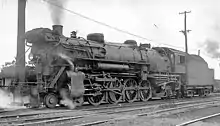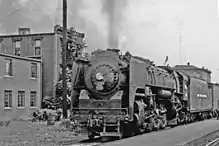New York Central Mohawk
The New York Central Railroad (NYC) called the 4-8-2 type of steam locomotive the Mohawk type. It was known as the Mountain type on other roads, but the mighty New York Central didn't see the name to be fitting on its famous Water Level Route, so it instead picked the name of one of those rivers its rails followed, the Mohawk River, to name its newest type of locomotive. Despite the more common name, the 4-8-2 was actually suited in many ways more to flatland running than slow mountain slogging, with its 4-wheel leading truck for stability at speed.
Indeed, the New York Central became the largest user of this wheel arrangement in North America, with 600 locomotives of this type built for its service; only the Pennsylvania Railroad came anywhere close, with 301 M1 of the type.
The Mohawk type was the pre-eminent freight power of the System, displacing the Mikado (2-8-2) type from first line service. While other roads obtained much more massive freight power, Decapods (2-10-0s), Texas (2-10-4) types and a multitude of articulated designs, the New York Central, with its practically gradeless high-speed raceways along the rivers, needed speed, not lugging ability.
The 600 Mohawks delivered were divided into four main classes, plus a few experimental and prototypes that were rebuilt between 1922 and 1939 .
L-1a,b,c,d

The first Mohawks delivered for the NYC were delivered by ALCO in 1916; these were purely freighters, with 69-inch drivers and small tenders. Further orders of L-1 subclasses followed in subsequent years, including some from the Lima Locomotive Works. All these locomotives had uncluttered lines as built, mostly thanks to the lack of such modern appliances as feedwater heaters, booster engines and the like. Many had feedwater heaters and other appliances added later, however. 185 L-1 locomotives were produced. The L-1a’s were numbered 2500-2529 the L-1b’s were numbered 2530-2584 the L-1c’s were numbered 2585-2639 the L-1d’s were numbered 2640-2684 .
Experimental 3-cylindered
The New York Central had two L-1 locomotives numbered 2518 and 2605 rebuilt by Alco in 1922 with three cylinders to help determine if three-cylinder drive was worthwhile. They were substantially more powerful than the two cylinder locomotives but it was debatable if the additional maintenance requirements of a third, central cylinder, valve gear, main rod and crank axle were worthwhile. in 1924 locomotive 2569 was rebuilt by Alco as Class L-1b-3 Cylinder. The NYC must have come down on the negative side of that question, for no more were built.
L-2a,b,c,d
.jpg.webp)
The next development of the Mohawk type for the New York Central was the L-2, 300 of its various subclasses being built between 1925-1930 by the American Locomotive Company. These were rather more modern locomotives than the L-1 class, fat-boilered, long-tendered, fitted with feedwater heaters, mostly of the Elesco type and generally mounted in front of the smokebox at the top, giving an aggressive, beetle browed look. Later L-2 subclasses, the L-2b and L-2c, had somewhat smoother lines with recessed feedwater heaters and cleaned up lines. The later L-2 locomotives, from a front-on view, appeared quite similar to the Central's fleet of Hudson passenger locomotives. The L2a’s were numbered 2700-2799 and the L2b’s were numbered 2900-2924 and the L2c’s were numbered 2800-2899 the L2d were numbered 2925-2949 and 2950-2999 however locomotives numbered 2995 and 2998 were modified for high speed in 1939 .
L-3a,b,c

The next development of the Mohawk type was that of the dual service locomotive, capable of working passenger as well as freight trains. Passenger service required the ability to work at 80 mph, as opposed to the 60 mph required of freight. The NYC's fleet of Hudson, 275 strong though it was, was proving inadequate to handle peak traffic demands, and some dual-purpose power would fix the problem nicely, as well as giving the ability to handle express freight and mail services.
Two L-2 locomotives were given modifications for dual service work; higher boiler pressure, smaller cylinders, light-weight reciprocating parts, dynamic counterbalancing of the drivers, roller bearings on all axles, etc. The success of these modifications prompted the construction of the L-3 class in 1940, 25 of which were built for dual service and the remaining 40 for freight only. The Class L-3a were numbered 3000-3034 the Class L-3b were numbered 3035-3049 the L-3c were numbered 3050-3064 all were built by American Locomotive Company .
All L-3 locomotives were given axle spacing that could accommodate 72" drivers, but only one was ever fitted with such. This locomotive, #3000, paved the way for the final class of Mohawks on the Central, the L-4.
L-4a,b’s
50 L-4 locomotives were produced by the Lima Locomotive Works in 1943. None of them had booster engines, although they were built to take them should they be ever needed in a dash, but they were not. The L-4s were truly dual purpose locomotives, and worked the heaviest freight and passenger trains during the war. The L-3 and L-4 classes had huge tenders riding on two six-wheel trucks that were almost as long as the locomotives hauling them, and were mostly coal space, a capacity for 43 tons of coal; water was taken en route using the tender scoop from track pans and thus the locomotives did not need to have that great an on-board water capacity. Some L-4s had Scullin Disc drivers. The L4a and L4b’s were numbered 3100-3124 and 3125-3149 . But all the L4a’s and L4b’s were scrapped.
Many L-4 locomotives were fitted with smoke deflectors later on.
Preservation
Only Two Mohawks out of the original 600 built have been preserved, making them the most numerous examples of New York Central steam power that were remaining to survive after all NYC's Hudsons and Niagaras were scrapped with none left for preservation. The first, #2933, is a 1929 ALCO-built L-2d and resides at the Museum of Transportation, St. Louis, Missouri while the second, #3001, is a 1940 ALCO-built L-3a at the National New York Central Railroad Museum in Elkhart, Indiana.
Tenders for two other Mohawks still exist as well. The tender from 2662, a class L-1d, is currently in use behind Lake Superior and Ishpeming Railroad 2-8-0 34 at the Western Maryland Scenic Railroad. The tender for L-3b 3042 was converted into a water tender and used with Reading T-1 4-8-4 2101 during its tour with the American Freedom Train, as well as with the Chessie System Special. It was later damaged in a roundhouse fire in 1979 . This water tender is now behind 3001 at the National New York Central Railroad Museum in Elkhart, Indiana.
See also
PRR M1- The Pennsylvania Railroad's version of the Mohawks. Also a dual mode 4-8-2 "Mountain" type steam locomotive.
References
- Staufer, Alvin F. (1961). Steam Power of the New York Central System Volume 1 ~ Modern Power ~ 1915-1955. Medina, OH: Staufer.
- Westcott, L., ed. (1960). Model Railroader Cyclopedia Volume 1: Steam Locomotives. Waukesha, WI: Kalmbach. ISBN 0-89024-001-9.
- Barris, W. "New York Central Mohawks". SteamLocomotive.com. Retrieved January 7, 2003.
- Morgan, David P. (1975). "The Mohawk That Refused To Abdicate". The Mohawk That Refused to Abdicate, and Other Tales. Milwaukee: Kalmbach. Reprinted from an issue of Trains magazine some time between April 1954 and November 1958.